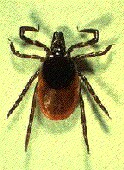
FRIDAY, July 11, 2014 (HealthDay News) — Reducing the number of deer in an area can lower the incidence of Lyme disease and other tick-borne infections among people, new research indicates.
“Our study demonstrated that deer populations can be manipulated to reduce human interactions with deer, infected nymphal ticks and human risk of contracting Lyme disease,” the researchers wrote.
White-tailed deer are the primary host for adult blacklegged ticks, which transmit Lyme disease to people.
The study included nearly all the permanent residents of a Connecticut community who reported their cases of Lyme disease between 1995 and 2008. The researchers found that a hunting program to reduce the number of deer in the area led to a significant reduction in the number of cases of Lyme disease.
Reducing deer density by 87 percent — to 5.1 deer per square kilometer (four-tenths of a square mile) — resulted in a 76 percent reduction in the tick population, according to the study, published recently in the Journal of Medical Entomology.
This led to a nearly 50 percent reduction in the rate of tick-related diseases among residents, and an 80 percent reduction in Lyme disease cases, the researchers said.
“Reducing deer populations to levels that reduce the potential for ticks to successfully breed should be an important component of any long-term strategy seeking to reduce the risk of people contracting Lyme disease,” the researchers concluded.
More information
The U.S. National Library of Medicine has more about Lyme disease.
Copyright © 2025 HealthDay. All rights reserved.

